Abstract
This study seeks to advance upcycling methods in fashion practice with the specificity of design methods that centre on revaluation and resignification of waste materials. The development of three key approaches to upcycling were tested for future application as design briefs and pedagogies in practice and education. These were developed through the acquisition, sorting and selection of a large sample of secondhand, consumer waste materials across fashion and textiles sectors. Practice-based experiments and the use of different forms of photo documentation examined and explored distinct ways to creatively understand waste material properties, conditions and potential. Fashion and material studies frameworks of object biographies, wardrobe studies, waste, secondhand material economies and art practice approaches of reclaimed materials expanded and refined the approaches. “Material Inventories” is proposed as a creative and analytical method to identify, sort and annotate pre- and post-consumer waste materials. “Garment ontologies” delineates how traditionally “design” in fashion practice is separate from materials and production. These methods enable a deeper investigation into material qualities, conditions, and reuse potential for extended life cycles. This experimental study presents novel and relevant findings with a compelling material sample and practice-based methods adjacent to scholarship in this area that are predominately theoretical- or case study-based.
1. Introduction
There is a growing body of research around upcycling in fashion practice and education using various research methods and approaches. Defined as a strategy to reduce environmental impact, upcycling combines circular material flows of products and materials and slower consumption cycles [1]. There are distinctions in research around upcycling also being referred to as “remanufacturing” [1,2] depending on context and scale. Most studies include comparative case study analyses of upcycling projects from fashion brands [3,4,5] or upcycling projects applied as special design briefs in fashion education [6]. Identified in fashion practice as the use of discarded materials transformed into higher value products [3] (p. 69) in research on the differences between standard and upcycled design and production processes in the industry [1], upcycling is associated with creating higher value or “conceptual fashion products” [5].
Standard fashion design processes, such as researching trends, sketching design, developing technical patterns and sourcing materials [3] (pp. 72–73) limit upcycling and potentials for extending life use. Post-use waste materials are usually added to standard design and production flows. Design is still considered largely a two-dimensional process distinct from manufacturing and separate from material conditions. Our study assumes the need to re-evaluate design methods used for upcycling with a closer integration with the way materials are identified, understood, and used. We assert the provocation of “garment as material” to suggest a rewiring of the design process to put materials first that are acknowledged already as products to design with or through. This embeds extending product life as it positions the student or designer within a paradigm of already designing with existing garments and their associated histories and lives.
Delving more deeply into waste material, economies and provenance leads to contextual research on material and cultural studies “object biographies” [7,8] and wardrobe studies [9,10]. Speculating on the origins, production and life of materials overlays an analytical framework to annotate, document and examine potential. Cases in contemporary art practice show found or reclaimed materials used in art practice, by being documented, catalogued, or repurposed in sculptures [11,12,13]. These communicate the poetics of waste and the politics of consumption, values, memories, and material cultures. We propose “Material Inventories” as creative and analytical methods to identify, sort and annotate our sample of materials of vast and varied styles, genres, materials and functions.
The methods we propose aim to advance upcycling practices with practice-based experiments and the use of a large sample of consumer waste materials. The novel approach and use of practice-based methods are relevant and provide much needed specificity for practice or pedagogies in fashion education. Garment biographies as a methodological approach can be described as collecting, categorizing, and grouping materials. This expands anthropological and material studies approaches to speculate about material origins, use and potential. The collective approach of methods as “garment ontologies” aim to delineate how traditionally “design” in fashion practice is separate from materials and production. The hope is that these methods will become a foundation to better design material life use, experience, and circularity. Collectively these design methods enable a deeper investigation into material value, qualities and potential that are crucial in upcycling practices and their future applications.
2. Contextual and Theoretical Review
2.1. Upcycling and Remanufacture Methods
Upcycling and remanufacturing are interchangeable with differences depending on industry context, sectors, and scale. Remanufacturing is used in a broader range of industries such as engineering, electronics and automotive, whereas “upcycling” is more commonly referred to in fashion industries [1] (p. 5). Remanufacturing restores cast-off products to a useful life via restoring condition, finish, or function to achieve a quality “as good as new” [1] (p. 5). By contrast, the goal for upcycling is mostly to achieve a higher value at retail than the original material product. Definitions of remanufacturing include key stages of dealing with the materials and their changes, which are useful to consider in relation to design methods for upcycling. Sundin suggests an umbrella definition of remanufacturing as “an industrial process whereby products referred to as cores are restored to a useful life” [2] (p. 2). The remanufacturing process includes inspection, disassembly, partial replacement, refurbishment, cleaning, reassembly, and testing, to ensure the remanufactured product meets the desired product standards [2]. Remanufacturing is more often considered an industrial process carried out in a factory environment. Upcycling processes tend to be classified as craft-based, artistic, individual, and requiring manual interventions.
There is scope for upcycling design methods to advance through taking note of the more clearly defined material stages of “remanufacture” and a variety of interdisciplinary approaches. Upcycling is used in fashion practice and education often as special projects or ranges, and usually standard design methods still apply. Foundational fashion pedagogies privilege skill acquisition as a way to learn how to design and this is based on the use of new materials to learn from. Students learn to design by making pattern templates using paper, testing designs construction in calico material and further sampling and prototype refinement in like materials. These are all learnt with new materials embedded in the process. There is a lack of key phases where materials are considered deeply and explored in a systematic way to inform and improve design. Research on this area often uses case study approaches to outline the design processes involved while neglecting other methods. In Marques et al., an upcycling competition for designers references various standard parts of the design process such as the use of an “inspiration board” and “concept board” to seek out trends and designs. These concepts are then applied to an experimental design phase where a chosen product is explored [5] (p. 1064) and materials are then assumed to be applied.
In other case studies of upcycling practices, there is little distinction of how the design methods differ when using waste materials and not new materials. Upcycling is referred to as “a method not only of redesigning old products but also as a sustainable method of creating a new item of clothing which has a longer shelf-life” [4]. Discussion around how design might change when designing with the changed material conditions of waste materials is a gap in scholarship. Focus is on the aesthetic appeal of the outcome of methods such as value adding or upgrading “a product that is low-level to a higher-level product, after technical processing” [6]. Design processes are only vaguely alluded to, and the standard practices apply: “textiles with less value are innovatively designed to creative and fashionable products.” [6] (p. 2). These studies do not address the specificity of design methods for upcycling practice that our research seeks to advance as distinct from standard design processes. To expand our approach to upcycling we explored literature on the poetics of waste, secondhand material economies, the wardrobe, and object methods and reclaimed materials in art.
2.2. Wadrobe and Object Methods
In exploring ways to advance design methods for upcycling, we address wardrobe methods and approaches from the sustainability and slow fashion scholars Kate Fletcher and Ingun Klepp [9] and also Klepp and Bjerck [10]. This includes both theoretical fashion study frameworks and practice research investigating and interrogating personally acquired or preowned garments as a “wardrobe”. The aim is to foster greater understanding of the materials in our own possession, and how interrogating a wardrobe composition could provide insights as to how to give rise to deeper care and attachment to things. Various aspects of selecting, recording, documenting and interrogating a wardrobe are explored with interdisciplinary approaches. Our research approached the collection of a large sample of consumer waste materials as a scaled-up approach to wardrobe studies, dealing with approximately 300 pieces across the research team. In this way our selection criteria of materials were also broad so as to emulate the diversity of materials, products and possessions consumers may encounter.
From working across a selection or combination of materials in wardrobe studies, “garment biographies” as an approach treats garments as objects to be interrogated, informed by a material and cultural studies framework of the well-known “object biographies” [7,8]. This anthropological lens privileges all of an object’s existence—not just its consumption, but the production and exchanges that culminate in its lifetime in framework of “biography of a thing” [8] (p. 66). These are a series of questions to ask of an object, through future investigation, observation and speculation. These trace its origins of production, current life use, aspirational uses for such objects, expected periods of use, usefulness cultural markers, ageing process and end of life use and disposal [8] (p. 66). It is a framework used by scholars to overview provenance, sociological significance and possibilities in objects. In working with a large sample of materials, we started by creating material inventories recording biographical information influenced by this approach to understand more deeply the conditions of waste materials.
2.3. Materials, Waste and Consumption
In the context of this study “materials “refers broadly to fashion, apparel, accessories, underwear, home and interior products of various genres, categories and functions. As a fundamental aspect of practice: “Fashion is both material covering and materialist representation of the body” [14] (p. 150). Conditions and contexts of materials have significantly shifted alongside the increased capitalism and globalism of fashion industries [15] (p. 3). The downgrading of labour costs and materials in fast fashion practices produces a surplus of cheap, low quality and “single use” garments. Accelerated global supply chains and production cycles make a steady and fervent stream of new fashion products that adopt trends and reach stores sometimes within weeks of design conception. The price and value of these things has consistently been reduced with the intention for consumers to buy more often and dispose frequently. The throwaway culture symptomatic of the consumerist machine of fashion “trades on novelty and status anxiety for economic return” [16] (p. 18). This is a consequence of systemic “planned obsolescence” [17] wired into fashion industries. Material qualities are reduced in provisions to slash production and fabrication costs [12] (p. 3) in order to reach markets more quickly at lower price points. Cheap fashion products lose value and functionality quickly, wearing out after a short life cycle and become consumer waste.
Alice Payne and Carla Binotto [18] (p. 6) propose poetic and evocative definitions of waste as results of carelessness, things that might be deteriorating or unwanted by-products of other processes. It is also something the industry neglects engaging with and facing in the materiality of waste. Payne further argues that a widened understanding of design practice is needed for sustainable industry practices [19]. It is suggested that to reach a sustainable change in the fashion industry means a revaluation of the modes of knowing that have previously led to such “unsustainability” [19] (p. 6). This could be understood as revaluating how we have created and designed before with materials that have become waste. Surplus pre-use consumer waste fashion and textiles materials are referred to as “deadstock”, known as the unused and surplus products of a manufacturer [20]. The notion of designing with “deadstock” textile materials then cut into garments by brands is being readily embraced [20]. This only solves part of the problem, as design methods still embody the same approach based on using new materials.
2.4. Secondhand Material Economies
In recent years the supply chain and retail of secondhand materials has substantially increased. Industry white papers note that in 10 years, consumers demand for alternative ownership models or not purchasing “new” products will increase significantly [21]. The materials sourced in this study were secondhand and pre-use, meaning previously worn, damaged or deadstock. These are distinct from luxury, vintage or designer secondhand garments [22] (p. 3) that retain and even augment value in resale over time. Secondhand goods are acquired due to previous use, historic association and value [15] (p. 8). They are also defined as “surplus of goods whose use-value is not expended when their first owners no longer want them” [23] (p. 134). For materials deemed valueless, “rag picking” [24] emerged in the 19th century as counter trade economies of lower quality, damaged and well-worn used materials. Taylor [25] examines the life cycle stages of these types of materials scavenged by rag pickers, as use, abandonment, resurrection and upcycling. When a material is beyond any further use, mending or value in other market categories, it is destroyed to become rags. Reduced of wearable function and shredded into scraps, it is also defined as “downcycling” by Taylor [25] (p. 2).
Waste materials are a significant concurrent market and supply chain in fashion [26]. At a mass scale, post-consumer waste materials go through various stages of identification, grading and re-selling, extending across the Global North and South [26]. Mass stocks in Europe or America are graded and sold off and then shipped off to places such as Ghana, Africa [26]. Waste garments are sorted, hand-picked and selected in various categories of garment type, genre, brand, material construction, fibre composition or colour and sold in various sized kilogram cubes [27] (p. 94). Throughout the secondhand market trade, materials shift in value and life stages. Many of these garments have been traded and circulated in vast and varied lives [27] (p. 94) or have been barely worn [26]. The study addresses the need for design methods to understand specifically these as materials contexts and conditions to design with as a current and urgent reality.
2.5. Reclaimed and Found Material in Contemporary Art
Reclaiming and finding existing materials is an established part of contemporary art practice, offering an insightful approach to upcycling methods. Using salvaged and scavenged materials explores everyday life, consumption and value. Assemblages of found materials is part of the work of Japanese artist Yuji Agematsu. The artist uses micro debris and rubbish to create small compositions in cellophane sleeves from discarded cigarette packs and resin, arranged in acrylic vitrines, consisting of a daily pick of finding waste debris on floors, streets, collecting, collating and categorizing as “diminutive sculptures that are diaristic records” [11]. As fine arrangements of waste framed and presented as art, the expressive qualities of the materials and their value are enhanced. The relationships formed by combining assemblages, compositions and sculptures of waste materials in this way informs the approach to our design methods. Part of upcycling is how the value of materials is “framed” through design, and how we might see them differently.
Photographic documentation of arrangements of found materials is also a key part of working with waste materials. Artist Taryn Simon in Contraband [12] occupied customs areas at John F. Kennedy airport in New York, continuously documenting items seized over a period of a week. Photographed like e-commerce product shots, Simon meticulously catalogued items, such as unregulated medicines, black market birds and counterfeit Louis Vuitton bags wrapped inside ersatz copies. Sorting and categorizing collections of found materials, Simon’s work has influenced the considered approach to visual documentation in the study. Some items captured by Simon are combinations of consumer goods created to conceal or hide counterfeit items. Ulterior and unexpected use of consumer goods proposes ideas towards combinations of materials that transcend their original purpose. In another critique of consumption, artist Michael Landy created an inventory of their life, documenting every personal possession, product and belonging [13]. Landy systematically deconstructed, destroyed or “downcycled” all their belongings, creating vast and detailed inventories and lists of materials [24]. These contextual and theoretical ideas provide an expanded and advanced framework for understanding waste material potentials in fashion practice.
3. Materials and Methods
Design methods were tested, explored, iterated and redefined for future application as design briefs in practice or as critical pedagogies in education. This article focuses on the first part of the research around the establishment of a variety of upcycling design methods for future applications. The key methods include the sourcing of a large sample of materials and creative practice experiments, performed at the Swedish School of Textiles during 2019. Materials were sourced from local Swedish medium-size enterprises in the not-for-profit sector that retail post-use consumer goods or unused industrial surplus. All researchers were involved in the sourcing and collating of “material inventories”, establishing a sample of materials. The sample included around 300 pieces across fashion, apparel, underwear, accessories, bed, bathroom, home textiles and products based on a broad selection criteria including the following:
- Garment type or product categories, e.g., dress, t-shirt, jacket, towels, blankets;
- Occasion, genre or function, e.g., formal, sports, winter, outdoors;
- Material type/construction and fibre composition;
- Colour, print, pattern, graphic motif or branded logo;
- Silhouette, form and volume.
The intention was to source a diverse sample of materials to amplify the scope of the design methods and be responsive to the context of what materials might be readily available. Each investigator began to sort and categorize their collected sample (approximately 50–60 pieces each), creating “material inventories” based primarily on information that could be extracted through observation of the materials (see Table 1 and Table 2). The inventory was based on type of garment or product, e.g., “dress” and a generic group “no.1”. This process was repeated for various garments, apparel and items across the sample. Biographical aspects of the materials beyond those captured on swing tags or garment labels were speculated through arranging and photographing. These informed the direction of design methods later defined as “material inventories” and “garment biographies”. The sensorial, aesthetic and expressive properties of materials were examined in these methods prior to any change.

Table 1.
Example “Material Inventories” from workbooks of a selection of dresses noted as category “no.1” with annotation of observational details and information from swing tags and garment labels.

Table 2.
Example “material inventories” from workbooks of t-shirts noted as category “no.2” with annotation of observational details and information from swing tags and garment labels.
Photography became an important method of testing material properties, examining the poetics of waste and speculating on the potential of upcycling. The focus was on visualizing and speculating how these methods might work in practice, reflecting the possibilities and real challenges faced when using these materials. A variety of technologies were used to produce images, including smartphone cameras, DSLR (digital single-lens reflex cameras) and an automated e-commerce photography machine called “Style Shoot Live”. The “Style Shoot Live” machine creates automatic e-commerce photography and video. The machine includes an all-in-one podium, backdrop, robotic-positioned DSLR camera and lighting. Products are photographed live on models, dress mannequins and shop racks, flat or folded [28]. This same technology is used by several fast fashion brands to efficiently produce online product shots, including Zalando, Forever 21, Kaufhof and Marks & Spencer [28]. The technology produces quick photographs in various formats and maintains consistent lighting conditions due it its use for e-commerce photography. The neutral lighting shows the details and physical properties of the materials, their colours, surfaces and textures.
To further explore and speculate on material biography, provenance and future use we also used a variety of physical tests and interventions to visualize function and potential use. This included arranging and combining different materials together to examine like qualities or difference. Working through an ontology of materials, we documented them in various stages and combined together as in the example shown in Figure 1, where three shirts are layered.
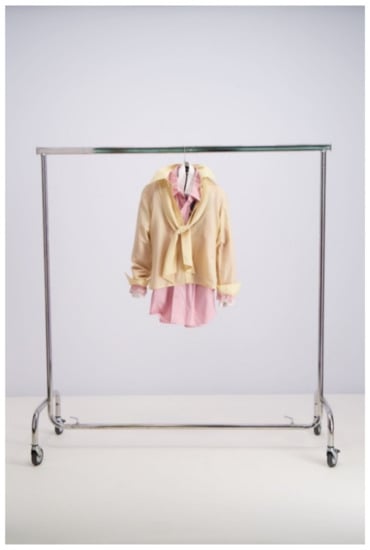
Figure 1.
Three shirts combined and layered together, documented hanging on a rack in the “Style Shoot Live” machine.
Combinations of materials after being grouped together were secured with removable tape and then also cut using an industrial electric rotary and a straight blade fabric cutter. Stages of this were documented, showing materials in various states of being combined, layered, stuffed and cut (see Figure 2). The method embodies artistic approaches around the use of found and reclaimed materials in creating assemblages and sculptures documented by photography. These methods are collectively captured as “garment biographies”.
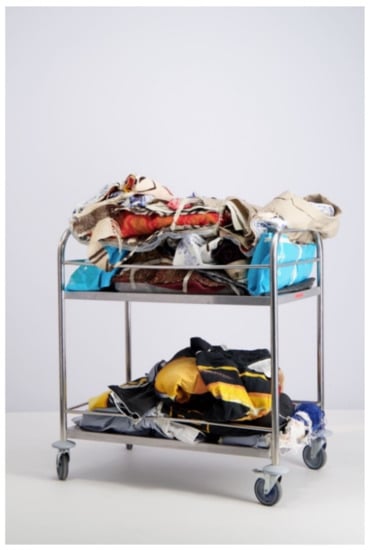
Figure 2.
Grouping of stuffed, rolled and folded materials after cutting into assemblages and fragments, documented in the “Style Shoot Live” machine.
Two other approaches were used to test specific aspects of upcycling design methods. These were less about exploring the materials’ physical properties and character and more about how these materials could function in relation to each other on a body, through silhouette, colour, print and pattern. Importantly, these approaches involved arranging materials flat on the floor and photographing planar (camera directly parallel) to the material to capture the complete length and dimensions. Smartphone cameras and DSLRs were used to quickly capture these formations. After completing the creative practice methods, the investigators reviewed the photographic documentation from the experiments across hundreds of images. Further contextual and theoretical review enabled refining these design methods from experimental studies.
4. Results
In total, three ontologically-based approaches were developed through experimental practice: garment biographies, topologies and geographies. Each method is presented visually in a number of steps to demonstrate its potential use within practice and pedagogies.
4.1. Garment Biographies
This method focuses on visualizing and speculating biographical data of materials, expanding the object analysis approach with photography and physical experimentation. The questioning of material origins, production, distribution, product use, cultural appeal, usefulness, wear and disposal are intended to be expressed in the images produced. Simple iterations are shown in Figure 3, with compatibility between colour, fibre and print and how the materials behave explored visually. In Figure 3e, three cotton t-shirts are layered showing how the materials catch and cling. In Figure 3g,h the t-shirts combined include nylon, spandex, cotton and polyester, revealing differences also in how synthetics might drape compared to natural fibres. To apply as a design brief or a pedagogy, this process would encourage designers to consider more deeply the properties of materials. This enables a more visual approach to Kopytoff’s framework for the “biography of a thing” [8]; the photographing process allows more time to examine the properties of materials before upcycling.
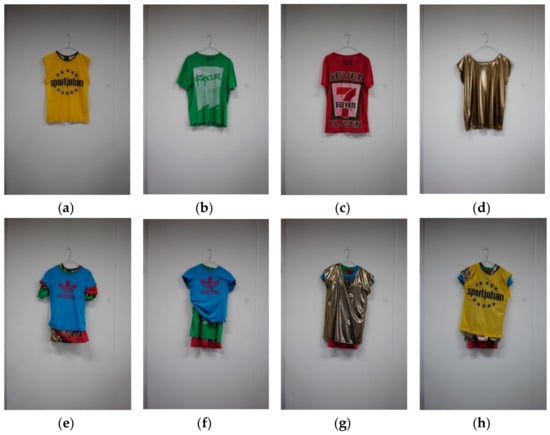
Figure 3.
(a–d) (From left to right) A selection of single use t-shirts on clothes hangers of variations of fibres, material, prints and motifs, photographed by DSLR camera. (e–h) (From left to right) Combining materials together on coat hangers to question the interaction between materials for potential use and wear, photographed by DSLR camera.
Variations included more playful ways to combine materials together, exploring function, creating assemblages and using cutting. Materials were placed inside one another, using layering of the same type and stuffing pockets, sleeves or other elements. The “Style Shoot Live” machine is effective in its capacity to show details of the materials. In Figure 4a–d an outerwear jacket is stuffed with various other like materials followed by the addition of cutting. Capacity of volume, form and size is also tested to reveal further possibilities for other uses of these materials.
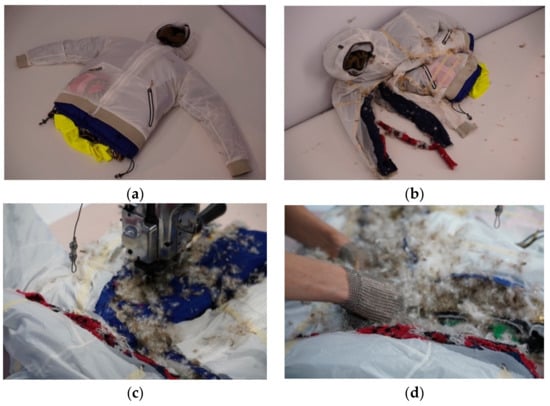
Figure 4.
(a) (From left to right) Outerwear jackets, puffers stuffed together with other materials, (b) then shown with masking tape lines and cutting of sections. (c) (From left to right) Showing the cutting process on the stuffed jacket with electric cutter, (d) revealing of various types of down and feathers.
In Figure 5. results are shown for testing materials across fashion and home categories with the addition of quilts and blankets. This shows systematic ways to explore more volume and thickness of materials together, and how their properties might relate. The use of cutting reveals the fibres that are concealed in padded materials, making tangible the fibres originating from animals or synthetics. Through the co-mingling of like materials, we can see the conditions these materials are worn in, e.g., for insultation and climate protection outdoors.
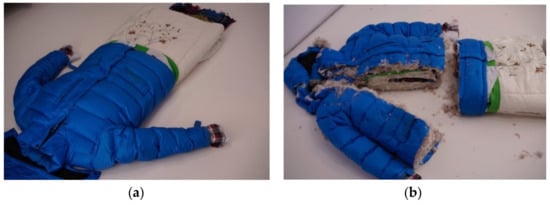

Figure 5.
(a,b) a puffer jacket is stuffed with layers of other materials such as blankets, quilts, shirts and t-shirts; (c,d) show the way in which the materials were folded together inside one another and then systematically cut to reveal cross sections of layers and fibres.
The iterations of various garment types in Figure 6 show the use of rolling materials individually and combined with others. The rolling compresses volume and creates layers that evidence physical, expressive and poetic qualities of the waste materials. This playful technique might be attractive to students and designers as it could conjure more imaginative upcycling potential. Some of the functional or practical qualities of the materials are dislocated, opening up opportunities to explore. In Figure 6d–f a Carlesberg beer bar towel rolled up with a wedding dress is an unlikely pairing of materials. The rolling reveals further some of their physical properties, such as the diaphanous skirt of the wedding dress, the flower-like form and the more robust and solid construction of the towel. Figure 6g–i shows a knitted sweater rolled with a plastic bag.
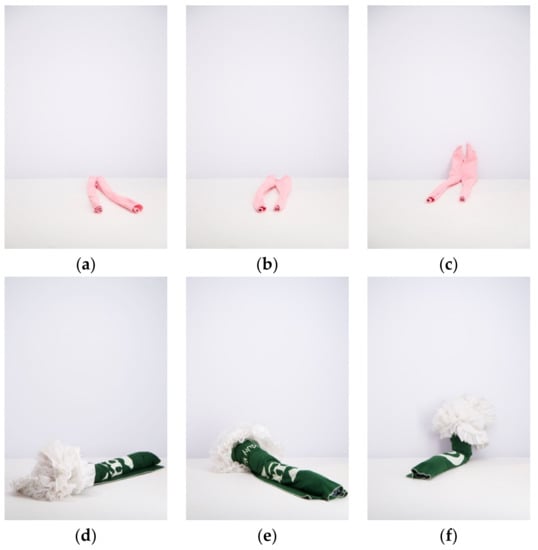
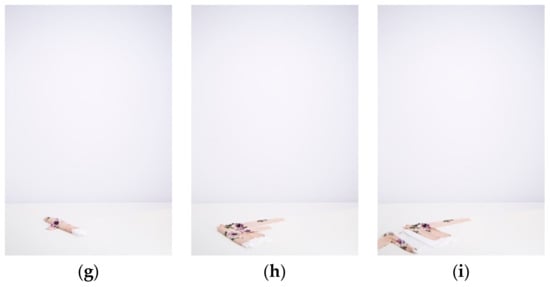
Figure 6.
(a–c) (From left to right) a pair of skinny jeans were cut down the side seam and then the legs rolled and photographed in the “Style Shoot Live” machine. (d–f) (From left to right) a wedding dress of polyester satin and nylon tulle wrapped inside a cotton Carlesberg beer bar towel photographed in the “Style Shoot Live” machine. (g–i) (From left to right) a cotton cut sweater folded with a plastic bag, then shown in various stages of being rolled, photographed in the “Style Shoot Live” machine.
4.2. Garment Topologies
With a different approach to photographing the materials, this method explores more closely a relationship between material, the body and wearability. Materials are photographed on the floor, with quick iterations and using smartphone cameras. The proposition of “garments wearing garments” is a hypothesis tested in various ways to combine and arrange materials collectively as “garment topologies”. In this approach there is no fixing, attaching or deconstructing of materials together; instead they are photographed in similar topologies such as material type, colour and genre. This method further usurps the notion of original material use and function, and the way these are intended to be worn; see Figure 7a–e. Material variables include using similar colours, such as in Figure 7a–e, to reveal how combining disparate material types might reveal alternate functions. The limitations of colour highlight differences in material performance, detail and function. In Figure 7e, a bathing suit is placed as the outer layer over pants and a blouse, suggesting another ordering of materials. It is the possibilities of interaction of garments remote from their norm positioning that is scrutinized here.
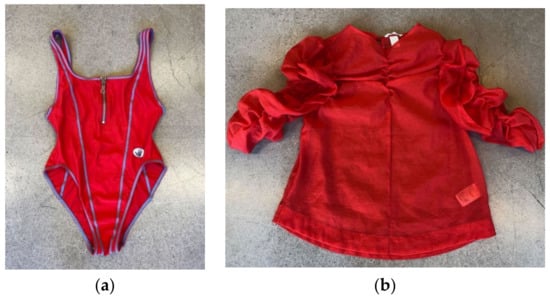
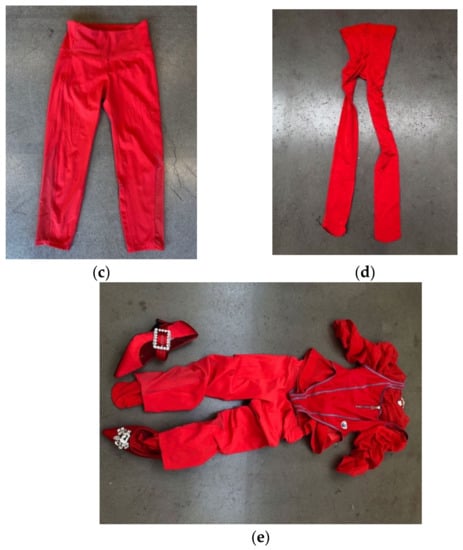
Figure 7.
(a,b) Upper body garments sorted into a red colour category including a nylon swimsuit and polyester blouse photographed by smartphone camera. (c,d) Lower body garments sorted into a red colour category including nylon elastane legging and nylon stockings, photographed by smartphone camera. (e) Combining garments—“garments wearing garments”—of the same colour across different types and the addition of shoes, photographed by smartphone camera.
Other iterations of material variables include limiting materials to a certain genre, type or fibre. Making compositions of materials in this way makes for wearable representations. This emphasizes qualities and characteristics about materials but also how they might be reconfigured together. Figure 8a,b shows different combinations of knitted stretch materials, highlighting arrangements of graphics but also how these synthetics might perform in proximity. In Figure 8c,d, the pajama pants from woven materials are folded and layered around each other. The qualities of the gathered waistband and drawstring also become enhanced. In Figure 8e,f, an ensemble of pajama pants and dressing gown is combined.
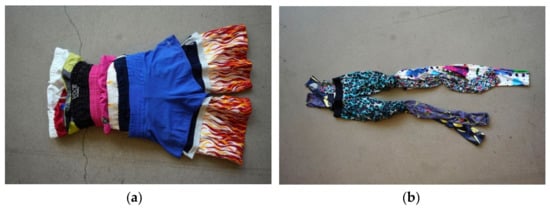
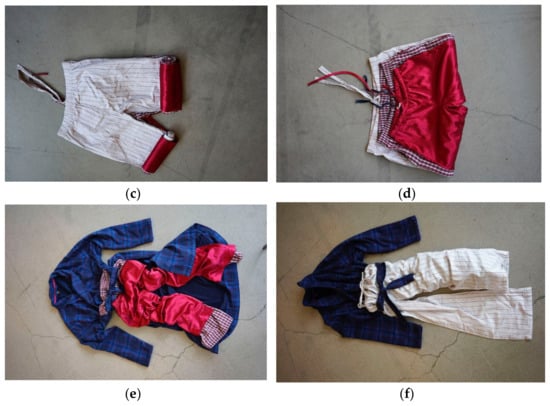
Figure 8.
“Garments wearing garments” of the same type: sport shorts in (a) and then leggings in (b), photographed by smartphone camera. (c,d) “Garments wearing garments” of the same type of pyjama pant, photographed by smartphone camera. (e,f) “Garments wearing garments” of the same type of dressing gown and pyjama pant, photographed by smartphone camera.
4.3. Garment Geographies
This method seeks to further abstract garment elements outside of a direct relationship with the body. Materials are arranged on a floor, and the use of lines (inserted with removable tape) suggest potential cropping instructions or areas for arranging, folding, and layering of garments in a two-dimensional image composition. Garment features and functions can be concealed through these different actions reinforcing the garment as a material approach. The method has two key variations in graphical constraints determining how the materials are arranged. “Crop the line” is the use of a taped line on the floor or two intersecting lines, which define areas where to fold or crop a material; see Figure 9a,b, where a Mackintosh garment is combined with two other garments and arranged around two perpendicular lines. The lines act as ways to examine a particular correlating detail between the related materials. The second iteration, called “The Square” (Figure 9), consists of four lines shaped into a square serving as a frame to arrange and fold garments. The aim is to abstract garments’ identity by reducing shape and details, enhancing and bringing forward specific aspects of garment’s character.
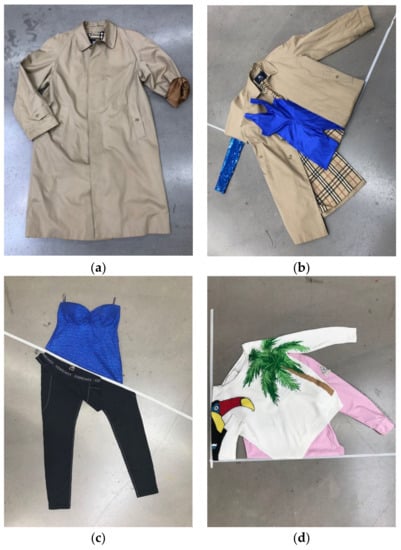
Figure 9.
(a) A Mackintosh coat, (b) then arranged with a blue sequin top and nylon elastane cycling trunks as part of “crop the line”. (c) A bustier dress is arranged with thermal tights with a diagonal line; (d) two sweaters are arranged related to their graphics.
These two iterations of the method show how garment silhouettes can be changed through the use of post-consumer waste materials, either simply as a tool to understand material, silhouette and line, or to be used in actual fabrications. This is a form of real life sketching with materials. When different colours or prints are added to these material image compositions, new forms could be identified through hybrids of garment parts, as well as combinations of graphics and prints. In “garment geographies”, deconstructing of form without cutting or disassembling is explored in material image compositions. In Figure 10, arranging materials around a taped square on the floor explores a larger composition or arrangement across several items. Through creating relationships between other materials in a “framed” composition, areas are isolated and enhanced. Whilst materials share some similar properties, the arrangements within a frame distort original silhouettes and how these materials might be applied.
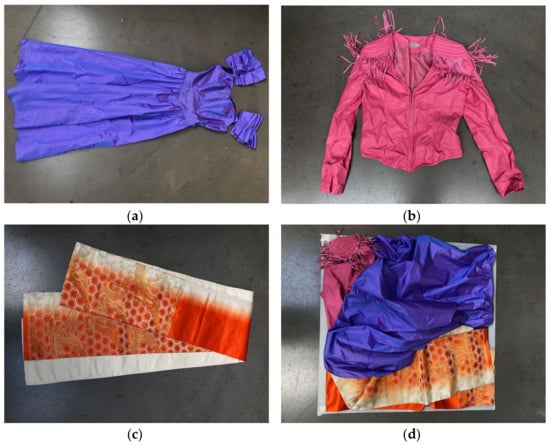
Figure 10.
(a) An evening dress and (b) jacket with fringing. (c) A Japanese silk robe sash and (d) showing the three materials arranged together in a square.
5. Discussion
5.1. Overview and Comparision of Design Methods
Table 3 provides a synthesis of the methods, with clarity on instructions that add definition to the way post-consumer waste can be used in a design brief in practice or a pedagogical setting. The identified methods have the capacity to transform design processes by a deep analysis of the values, performance and potential of consumer waste materials. Throughout these methods, a change in the perspective, value and performance of materials can occur. Low cost or single use materials can be interpreted objectively and beyond their context through the methods that abstract and amplify particular qualities. Throughout, questioning use-value in creative ways challenges the way these materials might be used in resolute outcomes. The privileging of materials in these methods with extended analytical and creative stages is a novel finding of this research. The visualized stages of sorting, combining, and cutting expands the understanding of materials and adds systematic stages that would be beneficial in both practice and education contexts.

Table 3.
Overview of the three methods, with descriptions, aims and instructions and variations that may serve as design brief or pedagogies.
Rather than just answering the questions about a biography of a thing through observation, “garment biographies” empower the participant to discover material properties, qualities and conditions through touch, images and arrangement. Questioning the materials life (past, potential and future) is done visually through the suggested techniques and different photography styles and technologies. “Visual methodologies” by Gillian Rose [29] offer a critical understanding of how images can be analyzed via different sites and modalities. These include the sites where images are produced; technologies to produce and view them; and composition. The differences in image technologies used affected the composition and how materials were arranged. Using methods that incorporate systematic forms of documentation enhanced material experimentation in the compositional qualities of the image and the social contexts—two of Rose’s [29] critical image modalities. The materials express variations of their potential life use and conditions they might be exposed to.
Physical interventions to the materials, such as layering, refer to precedents of ulterior uses of materials in Tarryn Simon’s work [23] where confiscated goods are shown wrapped and concealed inside others. Including cutting of materials echoes the reduction of function in downcycling processes, but reveals more about the properties of materials, which is often neglected in standard design processes. Capacity of volume, form and size is also tested to reveal further possibilities for other uses of these materials. This significant attention to exploring and testing the materials in detailed and creative ways is omitted in examples in scholarship of upcycling practices in fashion, in industry or education [3,4,5,6] but more so as a part of stages associated with “remanufacture” [1,2].
Recognizing and understanding various material qualities and contexts of garments within the same as well as other categories and building relations between them facilitates the training of analytical and creative skills. This encourages analysis around origins of secondhand materials, their histories and supply chains [20] in design practice. These design methods look beyond the known wearable provisions of certain garments and speculate beyond to advance how upcycling might occur. Forms become distorted, enlarged and engulfed in other materials, suggesting alternates beyond the body for garment reuse. The methods embed speculating and questioning where a material comes from, such as in the biography of a thing [8]. The way the material could potentially be reconfigured is suggested, e.g., making volumes in garments with reused garments instead of down or padding. This disorientates how materials might be configured in standard design processes.
“Garment topologies”, in comparison, focus on the exploration of wearable forms without destructing materials. A bathing suit is placed as an outer layer, a robe is tucked into pajama pants. It is the possibilities of interaction of garments remote from their norm positioning that is scrutinized here. The method facilitates the understanding of three-dimensional form that is inherent in the materials, and enables the testing of combinations of different garments regarding proportion and composition. Without the restriction of using a mannequin or standard representation of the body, wider possibilities of understanding fibres, material construction and their interconnections in producing volumes can be explored. This looks beyond the wearability of garments and their suggested use value and prioritizes a deeper analysis of them outside their original usefulness. Opportunities exist for these methods to be applied for outcomes across disciplines, and garments can be repurposed for various other functions outside of being worn by the body. Upcycling is procedural and requires several stages; this method serves as an alternative to two-dimensional techniques such as sketching, as the materials are used to create compositions to scale.
In reference to the stages of identifying materials in remanufacture, [2] “garment topologies” embeds an inspection phase and a testing phase. From Taylor’s identified stages of “rag picking”, the resurrection phase, where materials are reimagined for new life use, is also related. The methods add another fundamental and systematic stage around understanding materials prior to final construction. Garment biographies and topologies engage in combining garments together as three-dimensional arrangements with the different types of additional techniques and photography. In a similar way, “garment geographies” could be used in a pedagogical context to foster better understandings of garment silhouette, colour compositions and material palettes. Imagined deconstructing of form is simulated without cutting or disassembling explored in material image compositions. This way of looking at garments as in a “landscape” encourages a different type of perspective not afforded by looking at garments on dress mannequins. The method enables a consideration of proportion by revealing and concealing materials differently. The approach of systematic lines or a square frame could prove useful in practice if scaling up a sorting process across a very large sample.
5.2. Waste Material Market Conditons and Limitations
The materials selected and sourced in this research show a good indication of the range and availability of post-consumer waste in secondhand markets. The sample of approximately 300 pieces demonstrates greater market and economic conditions that would vary in different geographical locations and scales of secondhand/donated goods retailers. These sites are a common source of acquisition of materials for students and designers. The fashion, apparel and accessories materials were notably single use or barely worn items from large and fast fashion brands. Materials were readily available that were trend-based, seasonal, sometimes with swing tags still attached and of low quality. The sample demonstrates the abundance of these materials in supply chains and the necessity for fashion design to address this. There was a focus on synthetic materials such as polyesters and nylon due to their high volume of use and availability and their lack of decomposability. The inclusion of other material types beyond fashion and apparel categories was also based on observing their large availability. Our hypothesis was also that broadening the sample collection in this way would increase the potential of design methods with diversity of materials and contrast.
A limitation to note is that whilst materials can be defined as post-use consumer waste, their “use-value” would not be deemed expended [23]. The reality of these materials’ that are low quality and discarded still poses challenges for how they can be used. The materials used in the sample in various stages of post or pre-consumer use (never worn) were deemed of value sufficient enough for reselling. Materials of less value, meaning use-value more likely expended, worn or not deemed desirable, are shipped out into lower grade secondhand markets or downcycled, and then ultimately to a land fill. As referred to in the contextual review, materials that are desirable, which retain further value or qualify as vintage, would be circulating in higher-end resale markets.
5.3. Future Research
5.3.1. Application of Methods as Critical Pedagogies and Curriculum
The study is part of funded research exploring institutional barriers to remanufacturing and reuse in higher education at the Swedish School of Textiles, University of Borås. The next phase of research focused on the application of these methods to pedagogies, courses and curricula across HE Fashion Design programs at the Swedish School of Textiles, University of Borås and School of Fashion and Textiles, RMIT University from 2019 to 2022. To adequately evaluate the design methods in this context will require a longitudinal study based on student experience and outcome over a number of years. A framework for “critical pedagogies” could suggest the way these methods may relate to equality and ethical and environmental responsiveness in curricula. Student experiences and outcomes could be analyzed from this perspective through visual methodologies [29] and object analysis across institutions. The aim is to propose connections and applications of the design methods as intrinsic to critical pedagogies for change in fashion practice and education.
Taking a wider perspective could involve how these methods could be activated across courses as well as serve as scaffolding for material knowledge and learning for reuse and upcycling across academic programs. The methods have particular relevance considering the way fashion pedagogies have significantly shifted during the global pandemic. The fashion system being disrupted by precarity of resources and access limitations continues to affect how design happens. Students face deeply altered learning: digital and remote, restricting how they work and their access to materials.
5.3.2. Expansion of Methods with Further Material Conditions and Manufacture Methods
The creative practice experiments were limited to using accessible post consumer waste materials readily available in secondhand retailers. The methods could be further tested across industrial surplus of scale, meaning working with a large sample of the same material. This has the capacity to narrow in on methods that are scalable and adaptable to industry contexts. The more systematic aspects, such as the use of lines to sort and categorise, might work well in a repeatable and scaled-up technique to deal with a large sample of materials. Testing of these methods on materials deemed expended in use value could also be important, such as those with visible signs of wear, that could provide additional approaches to mending and reuse practices.
Manufacturing methods were outside the scope of our study due to the focus on providing ample ways to better understand and explore waste materials. The methods do have a capacity to be expanded into related manufacture techniques, meaning correlating methtods with tangible and scalable methods to attach, fix and finish. There is scope here for this to include standard fashion and textile manufacturing methods as well as advanced technologies such as ultrasonic welding for synthetic materials.
6. Conclusions
The design methods found in this study offer the capacity to enhance the standard design process by incorporating waste materials and advancing upcycling practices. Much focus is given to exploring the physical properties of the materials, changing values, performance and the potential to better equip design for a circular economy. Through heightening the expressiveness of the materials in the different methods and specific conditions, the potential for extended use and life cycles can be further explored. The physicality of the materials come first in all of the methods explored, asserting garments as materials as a consequence of inventories of waste materials circulating in mass in fashion and textile economies. The methods themselves imply the evolution of the discipline, and the need for responsible practitioners requires an interdisciplinary approach to break down barriers for how design happens and what it produces.
Author Contributions
Conceptualization, C.T.; Methodology, R.B., E.B., A.L., S.M.d.O. and C.T.; Formal Analysis, R.B., E.B., A.L., S.M.d.O. and C.T.; Investigation, R.B., E.B., A.L., S.M.d.O. and C.T.; Writing—Original Draft Preparation, R.B., E.B., A.L., S.M.d.O. and C.T.; Writing—Review and Editing, R.B.; Visualization S.M.d.O.; Project Administration, C.T.; Funding Acquisition, C.T. All authors have read and agreed to the published version of the manuscript.
Funding
This research was funded by VINNOVA—Circular and biobased economy project “Responsive design: exploring institutional barriers to remanufacturing and reuse in higher education”.
Institutional Review Board Statement
Not applicable.
Informed Consent Statement
Not applicable, all experiments and data collected in this study involved only the research investigators and no other human participants or data was used.
Data Availability Statement
Not applicable.
Acknowledgments
This project has been supported by the Swedish School of Textiles, University of Borås, and tRMIT University, School of Fashion and Textiles, Melbourne, Australia. All participating authors were contributing investigators in the research project.
Conflicts of Interest
The authors declare no conflict of interest.
References
- Sinha, P.; Senthilkannan Muthu, S.; Dissanayake, G. Remanufactured Fashion; Springer: Singapore, 2016. [Google Scholar]
- Sundin, E. Product and Process Design for Successful Remanufacturing. Ph.D. Thesis, Linköping University, Linkoping, Sweden, 2004. [Google Scholar]
- Han, S.L.C.; Chan, P.Y.L.; Venkatraman, P.; Apeagyei, P.; Cassidy, T.; Tyler, D.J. Standard vs. Upcycled Fashion Design and Production. Fash. Pract. 2017, 9, 69–94. [Google Scholar] [CrossRef]
- Koh, A.; Kim, S.Y.R. Code: Upcycling Deadstock Fabrics Into a Fashion Brand. In Bloomsbury Fashion Business Cases; Bloomsbury Academic: London, UK, 2018. [Google Scholar] [CrossRef]
- Marques, A.D.; Moreira, B.; Cunha, J.; Moreira, S. From waste to fashion—A fashion upcycling contest. Procedia CIRP 2019, 85, 1063–1068. [Google Scholar] [CrossRef]
- Chao, H. A Pilot Study of Upcycling Methods for Fabrics of Sustainable Fashion. IOP Conference Series. Mater. Sci. Eng. 2019, 677, 022134. [Google Scholar]
- Appadurai, A. The Social Life of Things: Commodities in Cultural Perspective; Cambridge University Press: Cambridge, UK, 1988. [Google Scholar]
- Kopytoff, I. The Cultural Biography of Things: Commoditization as Process. In The Social Life of Things: Commodities in Cultural Perspective; Appadurai, A., Ed.; Cambridge University Press: Cambridge, UK, 1986; pp. 64–92. [Google Scholar]
- Fletcher, K.; Klepp, I.G. Opening Up the Wardrobe: A Methods Book; Nouvus Press: Oslo, Norway, 2017. [Google Scholar]
- Klepp, I.G.; Bjerck, M. A Methodological Approach to the Materiality of Clothing: Wardrobe Studies. Int. J. Soc. Res. Methodol. 2014, 17, 373–386. [Google Scholar] [CrossRef]
- Belcove, J. Making Time with Yuji Agematsu. The New Yorker, 14 January 2019. Available online: https://www.newyorker.com/magazine/2019/01/21/marking-time-with-yuji-agematsu(accessed on 14 June 2021).
- Simon, T. Taryn Simon: Contraband; Hatje Cantz: Berlin, Germany, 2015. [Google Scholar]
- Sooke, A. The Man Who Destroyed All of His Belongings. BBC.com, 14 July 2016. Available online: https://www.bbc.com/culture/article/20160713-michael-landy-the-man-who-destroyed-all-his-belongings(accessed on 9 September 2020).
- Lehmann, U. Fashion and Materialism; Edinburgh University Press: Edinburgh, UK, 2018. [Google Scholar]
- Gregson, N.; Crewe, L. Second-Hand Cultures; Bloomsbury Publishing: New York, NY, USA, 2003. [Google Scholar]
- Fletcher, K. Other Fashion Systems. In Routledge Handbook of Sustainability and Fashion; Fletcher, K., Tham, M., Eds.; Routledge: New York, NY, USA, 2015; pp. 15–24. [Google Scholar]
- Cooper, T. Longer Lasting Products Alternatives to the Throwaway Society; CRC Press: Boca Raton, FL, USA, 2010. [Google Scholar]
- Binotto, C.; Payne, A. The Poetics of Waste: Contemporary Fashion Practice in the Context of Wastefulness. Fash. Pract. 2017, 9, 5–29. [Google Scholar] [CrossRef]
- Payne, A. Designing Fashion’s Future: Present Practice and Tactics for Sustainable Change; Bloomsbury Publishing: London, UK, 2021. [Google Scholar]
- Cochrane, L. Reuse, Renew, Recycle! Is Making New from Old the Future of Fashion? The Guardian. Available online: https://www.theguardian.com/fashion/2020/sep/02/reuse-renew-recycle-is-making-new-from-old-the-future-of-fashion (accessed on 9 September 2020).
- McKinsey & Company, ‘State of Fashion’ Report. Available online: https://www.mckinsey.com/~/media/McKinsey/Industries/Retail/Our%20Insights/The%20State%20of%20Fashion%202019%20A%20year%20of%20awakening/The-State-of-Fashion-2019-final.ashx (accessed on 10 September 2020).
- Ryding, D.; Henninger, C.E.; Blazquez Cano, M. Introduction to Vintage Luxury Fashion—Exploring the Rise of the Secondhand Clothing Trade. In Vintage Luxury Fashion; Palgrave Macmillan: London, UK, 2018. [Google Scholar]
- McRobbie, A. Second-Hand Dresses and the Role of the Ragmarket; Routledge: London, UK, 1989; pp. 130–148. [Google Scholar]
- Tenant of Culture. The Rag-Pickers Discourse: A selected Guide. In Press & Fold: Notes on Making and Doing Fashion; The Street: New York, NY, USA, 2018.
- Taylor, L. The Several Lives of a Collection of Rag Dump Clothing from Normandy (1900–55): From Farm, to Dump, to Poverty Chic. Fash. Stud. 2018, 1, 1–38. [Google Scholar] [CrossRef]
- Slow Factory, ‘History of Resale Markets’. Available online: https://slowfactory.earth/courses/history-of-resale-markets/ (accessed on 20 March 2021).
- Brooks, A. Clothing Poverty: The Hidden World of Fast Fashion and Second-Hand Clothes; Zed Books: London, UK, 2015. [Google Scholar]
- Style Shoot. Available online: https://styleshoots.com/live (accessed on 15 January 2022).
- Rose, G. Visual Methodologies: An Introduction to the Interpretation of Visual Methods; Sage Publications: London, UK, 2001. [Google Scholar]
Publisher’s Note: MDPI stays neutral with regard to jurisdictional claims in published maps and institutional affiliations. |
© 2022 by the authors. Licensee MDPI, Basel, Switzerland. This article is an open access article distributed under the terms and conditions of the Creative Commons Attribution (CC BY) license (https://creativecommons.org/licenses/by/4.0/).